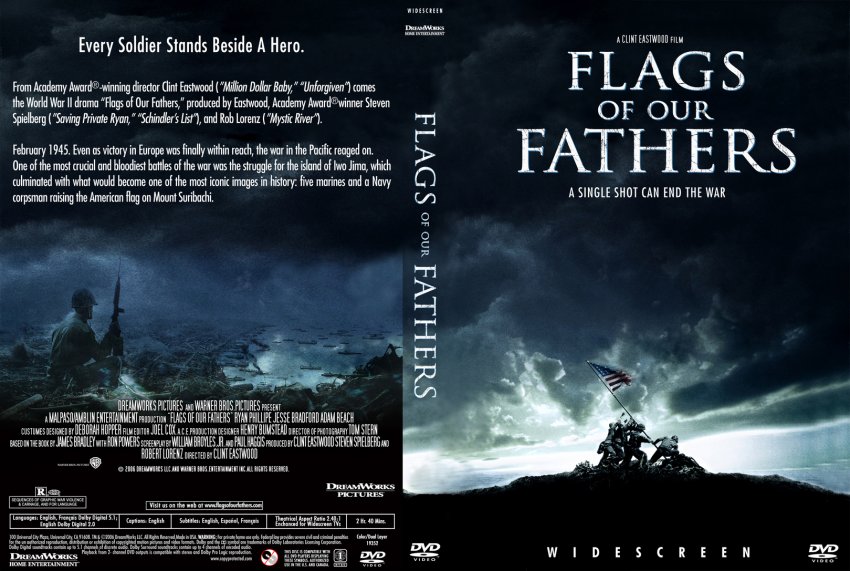
As Robert Burgoyne notes in his essay "Haunting the War Film: Flags of our Fathers," the photograph itself “haunts” Eastwood’s film and the men who appeared in it, arguing that “far from recording a searing moment of surpassing heroism, the photograph itself is a kind of double, almost an afterimage or an afterthought, a ‘second take.’” The battle went on for thirty-five more.īud Gerber: Well, what'd you do, raise a goddamn flag every time you stopped for lunch?Īs these revelations all surface throughout the film, the value of the photograph as an authentic object begins to dissipate. John "Doc" Bradley: This was the fifth day, sir. Ira Hayes: Yeah, we're in the goddamn picture.īud Gerber: Six guys raising a flag over Iwo Jima. Who is in the goddamn picture? Are any of you guys in the goddamn picture?

Yeah, why tell me? I'm only the guy that has to explain it to a hundred and fifty million Americans. The image’s status as an authentic representation of a past event is fundamentally challenged here, especially given the completely different cast of characters visible in the two photos, which ultimately leads to the misidentification of an individual in the photo.īud Gerber: Aw, that's it, that's beautiful.

When the Secretary of the Navy, James Forrestal, came ashore to observe the taking of Mount Suribachi, he requested that the original flag be replaced and brought to him as a souvenir. First, it is revealed that the famous photo actually depicts the second raising of the flag at Iwo Jima.
#FLAGS OF OUR FATHERS SERIES#
As Holger Potzsch notes in "Beyond Mimesis: War, Memory and History in Eastwood’s Flags of Our Fathers," Eastwood’s film in many ways recognises that the image functions as myth and matters not for “its objectivity or historical accuracy but its capacity to simplify complicated issues, to engage and motivate.” Įastwood challenges this mythic status by drip-feeding a series of revelations throughout the film about the photograph’s construction. The image functioned as a symbolic reminder of what was being fought for, and an attempt to reignite a sense of national pride and purpose. The image’s power derives from the soldiers' struggle beneath the flag, literally straining to uphold everything it represents.Īt the time that the image appeared, the United States was three years into the war and impatient for an end. įigure #2: Ira Hayes (Adam Beach), John Bradley (Ryan Philippe), and Rene Gagnon (Jesse Bradford) on the Seventh War Loan Drive in Flags of Our Fathers.Īt the center of the film lies the immutable power of that almost universally recognised photo, "Raising of the Flag on Iwo Jima." For most people, it is an undeniably visceral image, encapsulating notions of strength, integrity, and triumph over adversity. These three men were lucky enough to survive long enough after the taking of the photograph for it to become a media phenomenon, prompting the military to pull them from the front line to tour the United States as heroes for the Seventh War Loan Drive, which raised a staggering $26.3 billion for the war effort. Theatrical trailer for Flags of Our Fathersīased on the book of the same name by James Bradley, Flags covers the experiences of his father, John Bradley, and two other soldiers, Rene Gagnon and Ira Hayes, who appeared in the photo, "Raising of the Flag on Iwo Jima," taken by Joe Rosenthal during the infamously bloody Battle of Iwo Jima. But whilst most war films are inclined to suggest a definitive conclusion – that the costs of a war were or were not worth the sacrifice – Clint Eastwood’s Flags of our Fathers leaves this question unanswered.


Smith to Steven Spielberg’s Saving Private Ryan (1998), the flag has appeared as a ghostly apparition, inviting the viewer to meditate on the contrast between the horrors of war and the national values for which that war is being fought. From Tearing Down the Spanish Flag (1898), directed by Stuart Blackman and Albert E. Throughout the history of American war cinema, the United States flag has commonly been used a signifier of the nation’s ideals.


 0 kommentar(er)
0 kommentar(er)
